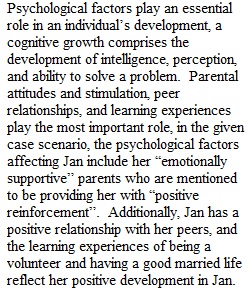


Q Overview You will refer to the case provided below to complete a case study analysis where you will identify whether the developmental concepts are guided by nature or nurture. Jan and Judi are identical twins who, tragically, were separated at birth after an administrative mishap in the hospital where they were born. After an ironic series of events that led to their reunion later in life, the twins’ story raises questions about the power of nature and nurture on human development. Jan was raised in a warm, loving environment where her identity was allowed to flourish in authentic ways. Jan describes her parents as very emotionally supportive, constantly providing her with positive reinforcement, which she believes has significantly contributed to her high level of self-confidence. After three years as the president of the debate team and after graduating from high school with high honors, Jan eventually went on to a successful law career. Jan has always maintained productive, healthy relationships with those in her personal and professional circles—social bonds that she has cultivated over the course of many decades. As a pillar of her community, Jan strives to help others in need through volunteering and advocacy. Jan married her childhood sweetheart and raised two very successful children (both lawyers). Now in her early 50s, Jan feels blessed for her good fortune in life. Sadly, Judi has not been as fortunate as her twin sister. She was raised in an emotionally chaotic environment; her father was an angry, abusive alcoholic, while her mother was anxious, depressed, and emotionally codependent. Since narrowly meeting the requirements to graduate from high school, Judi has been unsuccessful in her efforts to obtain and sustain gainful employment. Beginning in her teens, Judi found herself in psychologically abusive situations with significant others that resulted in severe emotional distress. Judi also states that she has very few friends. Throughout her life, Judi claims to have experienced paranoia, hallucinations, and severe depression and anxiety that have led her to abuse alcohol and drugs. Like her sister, Judi had two children with past partners; tragically, one teenage child died from addiction, while the other, nine-year old Jamie, is prone to angry outbursts and struggles with severe ADHD, anxiety, and depression. Now in her early 50s, Judi feels hopeless, helpless, and full of despair. Prompt The following resource supports your work on the milestone: • Module One Milestone Template After reviewing the scenario, use the Module One Milestone Template to complete a case study analysis. Answer each question with a minimum of 3 to 5 sentences. Support your answers with credible sources when appropriate. You must address the rubric criteria listed below: • Compare the psychological factors that have influenced both Jan’s and Judi’s development. o Consider their cognitive and affective factors in your response. • Compare the social factors that have influenced both Jan’s and Judi’s development. o Consider their relational and environmental factors in your response. • Explain whether nature or nurture had a more significant role in Jan’s and Judi’s development. Support your answers with examples from the scenario. o Consider using biological, psychological, and social factors in your response. • Explain why it is important to consider nature and nurture in combination throughout the life span when evaluating an individual’s well-being. Guidelines for Submission Submit your completed Module One Milestone Template. Sources should be cited according to APA style. Module One Milestone Rubric Criteria Exemplary (100%) Proficient (85%) Needs Improvement (55%) Not Evident (0%) Value Psychological Factors Exceeds proficiency in an exceptionally clear, insightful, sophisticated, or creative manner Compares the psychological factors that have influenced both Jan’s and Judi’s development Shows progress toward proficiency, but with errors or omissions; areas for improvement may include details related to cognitive and affective factors Does not attempt criterion 21 Social Factors Exceeds proficiency in an exceptionally clear, insightful, sophisticated, or creative manner Compares the social factors that have influenced both Jan’s and Judi’s development Shows progress toward proficiency, but with errors or omissions; areas for improvement may include details related to relational and environmental factors Does not attempt criterion 21 Nature or Nurture Exceeds proficiency in an exceptionally clear, insightful, sophisticated, or creative manner Explains whether nature or nurture had a more significant role in Jan’s and Judi’s development Shows progress toward proficiency, but with errors or omissions; areas for improvement may include supporting answers with examples from scenario Does not attempt criterion 21 In Combination Exceeds proficiency in an exceptionally clear, insightful, sophisticated, or creative manner Explains why it is important to consider nature and nurture in combination throughout the life span when evaluating an individual’s well-being Shows progress toward proficiency, but with errors or omissions; areas for improvement may include details related to nature or nurture in combination when evaluating an individual’s well-being Does not attempt criterion 21 Articulation of Response Exceeds proficiency in an exceptionally clear, insightful, sophisticated, or creative manner Clearly conveys meaning with correct grammar, sentence structure, and spelling, demonstrating an understanding of audience and purpose Shows progress toward proficiency, but with errors in grammar, sentence structure, and spelling, negatively impacting readability Submission has critical errors in grammar, sentence structure, and spelling, preventing understanding of ideas 10 Citations and Attributions Uses citations for ideas requiring attribution, with few or no minor errors Uses citations for ideas requiring attribution, with consistent minor errors Uses citations for ideas requiring attribution, with major errors Does not use citations for ideas requiring attribution 6 Total: 100% 0
View Related Questions